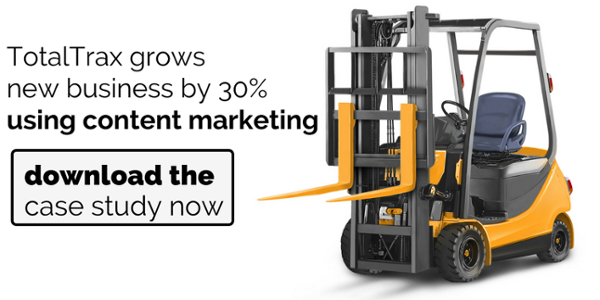
by Fronetics | Nov 9, 2016 | Blog, Content Marketing, Marketing, Social Media
Try these content formats and related tools for B2B social media content that keeps your audience engaged.
Conventional wisdom, careful market research, and common sense are all telling us that social media is transforming the way we do business. We know we should be leveraging these platforms to drive awareness, engagement, and revenue for our businesses. But creating content to share with your audience is actually more difficult than it sounds.
Character limits and the increasingly visual nature of these platforms means marketers are having to get creative with how they engage their audience. Here are four ideas and related tools that can help B2B organizations produce interesting, informative content that is suited to social media.
1) Video
The 2016 Social Media Marketing Industry Report rates the growing prevalence of video among its top findings for the year. It found that 60% of marketers are now using video in their marketing, and 73% are making it a goal to increase their use of video. This trend is for good reason — 64% of business that use video reported that it has led directly to increased sales.
Video is an efficient, visually appealing way to present your content in an imminently shareable format. Here are some online tools to help you create effective video content for your business.
- PowToon: A tool that guides users through the creation of animated videos and presentations, PowToon boasts an approachable interface and minimalist design that makes it simple for marketers with limited video experience.
- Magisto: Ideal for creating videos with emotional impact, Magisto features tutorials on creating video for your business, and allows users to create highly customizable video content through a simple interface.
- WeVideo: Featuring advanced video-editing tools with a simple interface, WeVideo is a cloud-based collaborative video editor that allows users the convenience of cloud video storage.
- Wideo: Allowing you to create videos in minutes, Wideo offers a variety of plans aimed toward working with your existing marketing strategy.
Creating your video is just the first step. Here are some places to upload and share your content:
- YouTube: The titan of video sharing services, YouTube allows for public and private upload, and gives users free access to analytics tools for their videos. Along the way, take a look at these valuable tips for getting more views on your YouTube videos.
- Vimeo: With a similar platform to YouTube, Vimeo is ideal for video sharing, discovery, and generating creativity.
2) Infographics
Social media platforms are becoming increasingly visual. A well-designed infographic makes your content visually appealing and delivers your message in a clear, easily digestible format. A recent report from eMarketer and the communications firm Lewis found the demands of social media and the format’s high engagement rates are key reasons for its use.
Here are some online resources that let you create and share infographics:
- ly: This site features a vast array of templates, which you can easily edit and customize and share immediately on social media platforms.
- Piktochart: With an easy-to-navigate interface, Piktochart allows you to create intricate, design-rich graphics, complete with icons, images, charts, and interactive maps, and publish them directly to social media platforms.
- Canva: This site allows for quick creation of infographics, as well as presentation covers, social media images, online advertisements, and flyers.
- Visme: A simple interface, Visme allows you to translate your ideas into engaging infographics, presentations, reports, and more. You can share your content online as a URL or on social media, embed it on your website, or download it.
3) Podcasts
The 2016 SME Report identifies podcasting as a relatively untapped way for marketers to engage with social media audiences. The audience for podcasts in the United States alone is close to 60 million people, making this medium a significant opportunity for businesses to engage with potential clients.
Here are some tools that can help you create quality audio content:
- Audacity: This open-source audio software lets you record audio, convert tapes and records into digital recordings, and add your own audio effects.
- Podbean: This tool lets you quickly create and share professional podcasts, no programming knowledge necessary. You can publish them directly to social media platforms.
4) Slides
If you have a lot of dense, industry-specific content that you want to get out to your audience, presentations are ideal. Breaking up your content into slides lets you get the information to your network in an engaging and visually appealing way.
Here are some tools that help you create and share professional presentations:
- SlideShare: LinkedIn’s platform lets you build, upload, and edit presentations, and share them on social media.
- SlideBoom: Ideal for converting PowerPoint presentations to Flash, SlideBoom lets you share your presentations with your target audience.
- Prezi: This tool is available for download or as an online editor, and it allows you to add animations to your presentations and share your content on Twitter, Facebook, and LinkedIn.
Social media has changed the way businesses engage with their target customer base. Embracing these tools is key to creating and maintaining an active and loyal audience.
Related posts:


by Fronetics | Nov 7, 2016 | Blog, Content Marketing, Logistics, Marketing, Social Media, Supply Chain
Fronetics is conducting a survey to determine how companies in the logistics and supply chain industries are using content and social media.
Have you ever wondered how your competitors, customers, and business partners are using modern marketing tools like social media? Are you curious how many companies like yours have a blog, how often they publish, and, more importantly, how many are generating new business from it?
Fronetics was curious about these questions and more. So we conducted our first industry-wide survey back in 2014 to learn how logistics and supply chain companies were using content and social media as part of their marketing programs.
The results were very telling. Though all reported leveraging these tools for only a short while, the majority had already seen a positive impact on their business. To read the full reports, click below.
Well, a lot has happened in two years. And, once again, Fronetics would like to take the temperature of the industry to see how the use of social media and content has changed (or stayed the same). So we are launching a new survey for individuals working in the logistics and supply chain industries to weigh in on how their companies are using these tools today.
Each survey takes about 3 minutes to complete. Results will be reported in aggregate, using no personal or company information from respondents. Those wishing to receive the completed report can indicate this preference during the survey.
Please click the buttons below to take our surveys. We look forward to hearing your responses!


Related posts:

by Fronetics | Nov 3, 2016 | Blog, Content Marketing, Marketing, Social Media
The web search has changed the way businesses shop for products and services — and content marketing is your key to reaching them.
What’s the first thing we all do when we need a gift for Fathers’ Day, can’t think of a song lyric, or want to buy a new kitchen appliance? We Google it.
The world of B2B sales is no different. Demand Gen’s 2016 B2B Buyer’s Survey Report found that 62% of B2B buyers say that a web search was one of the first three resources they use to learn about a solution. In fact, 94% of buyers reported using online research at some point in the purchasing process.
That means businesses must be more than just conscious of their digital presence: They must actively manage their website and digital content assets to accommodate the ways buyers are conducting research.
Seeing opportunity in the new reality
In the pre-internet age, the salesperson’s role began relatively early in the buyer’s journey. Today’s average B2B buyer, however, progresses nearly 60% of the way through this process before making any sort of contact with a sales rep. That means your prospects are forming their early opinions about your business and your products based on what they find on the web.
This new reality may seem daunting, given how much of the purchase decision-making process occurs before you have the opportunity to engage with a potential client. But in reality, this changing climate offers serious opportunities for businesses to demonstrate their expertise, without turning buyers off with overt sales pitches.
Content is king/key
To make the most of the potential purchaser’s experience with your business, content is key.
A robust content marketing strategy builds brand awareness, establishes trust and rapport with prospects, and generates traffic to your website. Thoughtfully generated and curated content catches the attention of buyers and keeps them interested in your business through the time of purchase.
Specifically, 67% more leads will be generated by companies with an active blog in 2016. And content isn’t limited to your website: a vibrant social media presence helps buyers conduct their research, with 57% of consumers reporting that they are influenced to think more highly of a business after seeing positive comments online.
Again, while this new reality may seem like a challenge, it’s actually a golden opportunity for your business to put its best foot forward with potential buyers. By thoughtfully generating and curating focused, informative content, companies can guide B2B buyers through the sales process, and develop an engaged and loyal customer base.
Related posts:


by Fronetics | Nov 1, 2016 | Blog, Content Marketing, Marketing
Companies dedicate enormous resources to ramping up email marketing programs around seasonal pushes, like the holidays. But do they actually get more customers?
We all know the feeling — how the office buzzes, the anticipation starts to build. Busy season is around the corner, and your team is getting ready for the big push to make this the most successful year yet. But have you ever wondered if all the extra hours and money you pour into these seasonal marketing campaigns are worth it?
As the holidays approach, many businesses, especially retailers and e-commerce companies, are starting to ask themselves this question — or, at least, they should be. At what point will creating and sending another email to your database be detrimental, rather than beneficial? How much should your messaging change? Should you try something totally new and different to catch customers’ attention?
IBM Marketing Cloud’s 2016 Email Marketing Metrics Benchmark Study has some interesting answers to these questions.
The holiday email-marketing study
The 2016 Email Marketing Metrics Benchmark Study is an annual report that offers insight on how many people open, click, and ignore messages from email marketers around the globe. It aggregates data from messages sent by nearly 750 companies representing 3,000 brands in 40 countries. This year, the study also examined the performance of holiday messaging versus non-holiday messaging for retail/e-commerce vendors.
Most retailers send at least double the amount of emails during the holidays (defined as Thanksgiving to New Year’s) as they do during the non-holiday period. They entice potential buyers with aggressive pricing, free shipping, and deal deadlines. But do these more frequent, offer-loaded emails make a difference? Let’s take a look.
Click and open rates
In almost every respect, non-holiday emails outperformed holiday emails in a significant way. Open rates during the holidays were 18.8% lower than during non-holidays. Mean click-through rates differed by 28%. Mean click-to-open rates remained similar.
There are several takeaways here. Yes, open rates were lower during the holidays. But because the volume of emails sent during this period increased significantly, it’s likely that the total number of emails opened was greater during the holidays than non-holiday period. That’s a positive thing.
That being said, click-through rates decreased pretty dramatically. You would expect that special holiday offers would entice recipients to click through more often. But increased email volume seemed to detract from such motivating offers.
Similarly, click-to-open rates measure the effectiveness of email content (in driving a reader to take the requested action, e.g. redeem an offer). These rates remained relatively similar across both time periods, which is surprising. With more people looking to make purchases during the holidays, you would think that more recipients would act on the offers presented in the holiday emails. Again, increased email volume seemed to detract from their doing so.
List churn metrics
Increased email volume meant retailers processed more hard bounces, unsubscribes, and spam complaints during the holidays.
Here are the takeaways. Firstly, more emails equal more hard bounces. That seems logical enough.
Though unsubscribe and spam-complaint rates were slightly lower during the holidays, that doesn’t equal success. Because of the frequency math effect, retailers are losing a larger number of subscribers because they are sending more emails.
Say your company sends one email per week during the year, and two emails per week during the holidays. If you usually have 10 people unsubscribe per week during the year, approximately 20 people are unsubscribing during holiday weeks. That can deplete your database pretty quickly — especially if you’re more than doubling your email volume.
Conclusions
The folks at IBM Marketing Cloud had some interesting thoughts about their findings and how to increase the effectiveness of holiday emails.
For one, while increasing the number of emails you send during the holidays isn’t inherently a bad idea, as more emails equates to more total opens, many retailers are going about it the wrong way, as is evidenced by lagging click-through rates.
That’s because when many marketers ramp up email volume, they forget all the best practices that make their emails successful in the first place: personalization, targeted content, and offers that are relevant to the specific recipient based on his/her place in the buyer’s journey. Personalizing email content will help improve click-through and click-to-open rates, which could dramatically impact sales given the increased email volume.
Further, a courtesy head’s up about increasing email frequency could reduce the number of opt-outs and spam complaints. IBM Marketing Cloud suggests that companies should “consider sending an email to subscribers before you ramp up frequency, explaining the increased frequency, what kind of promotions they can expect, and shipping and return policies. Include prominent language about frequency options and link to your preference center. In addition, revise your preference-center language and options to encourage unsubscribers to opt down or snooze emails instead of simply opting out.”
Application across verticals
While the weeks between Thanksgiving and New Year’s are not every business’s busy season, the findings from this study are still applicable. If your prospects experience an uptick in marketing emails during a particular season from you and your competitors, you’re likely to experience similar results.
The key in ramping up emails prior to a big push is to retain quality — that is, customizing content and offers to the particular recipient. If you can’t scale, then you shouldn’t send.
Furthermore, this study speaks to the value of a strategic, year-round marketing program that builds brand awareness and customer loyalty, regardless of how close the busy season is. If prospects grow to know and trust your brand, they’ll turn to you when it’s time to buy, regardless of how many emails you send them in the weeks prior.
Related posts:

by Fronetics | Oct 27, 2016 | Blog, Content Marketing, Marketing, Social Media, Strategy
Company X also saw web traffic grow by 180% in 90 days by using Google AdWords and Facebook Ads.
Sometimes our clients can be a little hesitant to try pay-per-click advertising. Take Company X, for example.
Company X’s target customer fits a very particular profile, in terms of geography, income, and age. Because of those specific demographics, the client was not confident that a pay-per-click advertising campaign would be an effective way to reach those target customers. But we thought differently.
When paired with a content marketing program, pay-per-click can be one of the cheapest, in terms of cost-per-lead, and most efficient ways to reach a target audience. Thus, we convinced Company X to try PPC on a trial basis, investing just a small budget.
We developed a strategy for the client, using Google AdWords and Facebook Ads. Over the course of 90 days, the results were phenomenal.
A few key results:
- Company X acquired 54 leads.
- Traffic from paid search grew by 180%.
- The lead-to-customer conversion rate was nearly 3x the industry standard.
Needless to say, Company X will be expanding the use of pay-per-click advertising in the future.
How can pay-per-click help your business?
PPC can seem intimidating to the novice. But, when done right, it can be a highly effective way to reach the very specific kind of customer your business is looking for. A little bit of know-how can be all the difference.
As such, Fronetics has developed a quick training on the basics of pay-per-click advertising: what it is, what platforms are available, etc. If you are interested in learning more about PPC and how it might complement your marketing program, download our free guide below.

Related posts:

by Fronetics | Oct 26, 2016 | Big Data, Blog, Content Marketing, Data/Analytics, Marketing
Big-data insights can help you segment your email database to better target prospects based on where they are in the buyers’ journey.
Most companies these days are swimming in a sea of big data, the great swaths of information they’ve amassed from sales records, social media connections, website leads and contacts, and online analytics.
At first glance it’s a tangle of information that is hard to organize and even harder to learn anything from. That’s a stumbling block that forward-looking businesses need to overcome. Big data can help breathe new life into one of the most reliable yet shopworn tools of the trade: email campaigns.
Embrace Big Data
A study by the executive head-hunting firm Spencer Stuart surveyed 171 companies regarding big-data usage. Just a little over half of the companies used their big data to help guide email, SEO, and SMS marketing campaigns. That’s a fairly low rate, given the potential leg-up that big data can provide.
Consider what Walmart is doing. The company has big-data information on about 60% of all Americans, with which it micro-targets customers based on their individual interests and habits. It’s a powerful strategy that is spreading quickly to businesses of all sizes.
How can you use big data to freshen up your email campaigns?
Be a Collector, Not a Hoarder
Chances are, you are obtaining a lot of data, especially if you have an active content marketing plan in place. Not all of the data you get is equally important. Your focus should be on data that can lead to an actionable and quick response — for example, are you gathering information on your customers’ buying habits? Do you know who they are, where they are, what their interests are, what their email address is, and how your business connects with them?
Collect that relevant data and study it. Much of it will come from the buyer’s journey — the breadcrumbs that potential buyers leave for you in your big data. These pieces of information are keys to your personalized email responses.
Respond In Kind
Most experts agree that a quick and targeted email response is a good strategy for encouraging a new customer to make a purchase. The email needs to respond directly to the buyer’s interests — using information you’ve (hopefully) logged with your big data.
From this point on, it’s crucial to make sure that every email that is sent to that buyer is built around a backbone of big data. Nurture your customers with personalized emails that offer content and deals that line up with their specific interests.
Don’t Mess with the Masses
Mass emails — the generic sales pitch email — used to be the cost-effective and simple way of reaching and converting customers. Now, it’s more than likely they’ll get sent to the trash, or worse, the spam filter. The mass email is your one-way ticket to spam purgatory.
“Traditional methods of mass marketing doesn’t resonate anymore and they’re being ignored by the audience,” said Volker Hildebrand, Global Vice President of Strategy at SAP Hybris, in a recent interview with Forbes. “Data is the fuel for customer engagement, and being able to pull together all the relevant information about in real-time.”
You can do better than the mass email approach. If you’ve collected relevant data and you’ve studied your buyers’ journeys, you have the tools in place to build a smart email campaign. Tailor your campaign to personalize your approach to your customers, and more than likely they’ll open that email.
Related posts:











